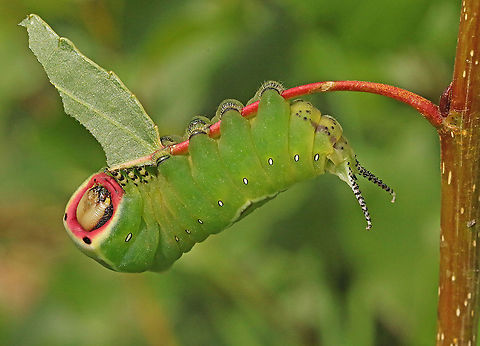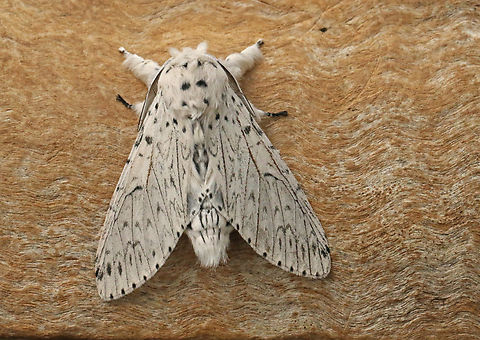
Appearance
''Cerura vinula'' has a wingspan of 58 millimetres to 75 millimetres – the males are slightly smaller. The head, thorax, and body of these moths are very fluffy, with a cat-like appearance . The antennæ are bipectinated. They have white or yellowish-gray forewings crossed by several wave-like dark lines. The hindwings are light gray or whitish in the males, while in the females they are suffused with blackish but almost transparent. The body is whitish gray, with the dorsal abdomen banded in black.The caterpillars grow to about 80 millimetres long. In its last stage they are bright light green and have a blackish-brown or purplish-brown dorsal pattern outlined in white or yellowish. Young caterpillars are completely black. The abdomen ends in a tail fork with two long dark-colored tips bearing red extendable flagellae. The chrysalis is reddish brown, enclosed in a hard cocoon attached to the host plant.

Naming
Subspecies include:⤷ ''Cerura vinula benderi'' Lattin, Becker & Roesler, 1974
⤷ ''Cerura vinula estonica'' Huene, 1905
⤷ ''Cerura vinula irakana'' Heydemann, Schulte & Remane, 1963
⤷ ''Cerura vinula phantoma''
⤷ ''Cerura vinula vinula''
Distribution
The moth is a Palearctic ecozone species and lives throughout Europe , across temperate Asia to China and in North Africa.Behavior
The flight period extends from April to August, depending on elevation, with one generation per year. Host plants include willow and poplar, especially the aspen, ''Populus tremula''.Females lay their chocolate-brown, 1.5 millimetres wide, hemispherical eggs on the upper side of the leaves of their food plants. The moth survives the winter as a pupa in a very solid wood-reinforced cocoon, usually attached to vegetation.
The caterpillars have a remarkable defensive behavior. When disturbed, they strike a defensive pose raising the head with a reddish area and waving the twin tails with pinkish extendable flagellae. They might squirt formic acid at the attacker if the defense warning is unheeded.
Habitat
This moth mostly lives in very dense woodland areas.References:
Some text fragments are auto parsed from Wikipedia.